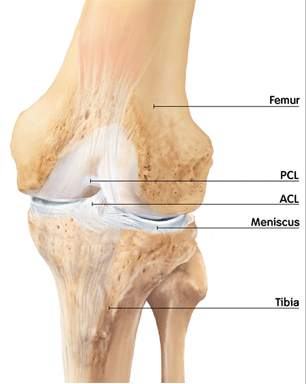
The knee is a complex joint made up of bones, muscles, tendons, ligaments,
and cartilage. It may be described as a hinge joint, similar to the hinge
on a door. The knee not only bends back and forth but also has a complex
rotational component that occurs with flexion and extension.
Each knee has two crescent-shaped menisci, or cushion pads. The lateral
meniscus lies at the outer side of the knee and the medial meniscus lies
at the inner side of the knee. The strong but flexible menisci act as
shock absorbers between the femur (upper-thigh bone) and the tibia (shin
bone), especially during weight-bearing activities such as walking or
stair climbing. The menisci also stabilize and evenly distribute your
body weight across the knee joint.
The ACL is one of a pair of crucial ligaments that forms a cross in the
center of the knee joint. Both the ACL and the PCL function to stabilize
the knee from front to back. The ACL limits the forward movement of the
tibia, and the PCL limits the backward movement of this bone. Additional
ligaments provide stability to other movements at the joint, including
angulation (left/right motion) and rotation. Without such stability, you
may feel that your knee is simply giving out from under you.
